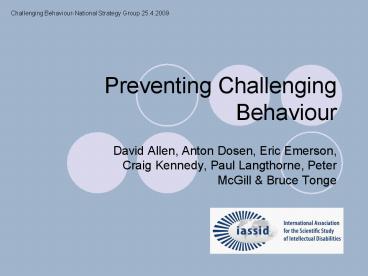Preventing Challenging Behaviour - PowerPoint PPT Presentation
1 / 10
Title: Preventing Challenging Behaviour
1
Preventing Challenging Behaviour
Challenging Behaviour-National Strategy Group
25.4.2009
- David Allen, Anton Dosen, Eric Emerson, Craig
Kennedy, Paul Langthorne, Peter McGill Bruce
Tonge
2
Epidemiology
- Combined prevalence rates for challenging
behaviour mental health difficulties in people
with intellectual disability 16- 41 (Cooper et
al, 2007) - Challenging behaviour accounted for 32-50 of
reported difficulties - Combined prevalence translates to 5-14 million of
the worlds population - 2-7 million with challenging behaviour?
3
Impacts
- People themselves exclusion, institutionalisation
, deprivation, physical harm, abuse,
misdiagnosis, exposure to ineffective
interventions. - Carers physical harm, physical psychological
ill health, increased burden of care and
financial consequences, reduced quality of life. - Commissioners/policy makers/providers escalating
costs, policy undermined, high staff sickness
turnover, service breakdown, scandal exposés.
4
Challenging behaviour is
- Relatively common
- High impact (social, clinical, fiscal)
- Long-duration
Significant Direct Indirect Lifetime Costs
5
Public Health Model
- Primary Prevention impacting on the incidence of
a condition by changing or altering exposure to
the factors that cause it (immunisation for
rubella, sun screen for cancer, plastic beer
glasses for violence, adoption of healthy
lifestyles for coronary disease) - Secondary Prevention screening for a condition
before it becomes symptomatic and intervening
early to reduce the likelihood of it developing
(screening for cervical cancer, screening for
high cholesterol modifying diet/using statins) - Tertiary Prevention providing intervention to
individuals who already have a condition in order
to prevent further disability and restore
pre-morbid functioning (insulin for diabetes,
psychotropic medication for psychosis)
6
Risk Markers for Challenging Behaviour
- Environmental
- social deprivation
- sensory material deprivation
- high levels of unpredictable stress
- repeated illnesses
- inconsistent practice
- high rate demands
- differential reinforcement of challenging
behaviour - high expressed emotion
- Personal
- male gender
- severe-profound ID
- secondary disabilities (communication, mobility)
- certain behavioural phenotypes.
7
Primary Prevention of Challenging Behaviour
- Reducing exposure to known risk
factorsReducing social deprivationProviding
enhanced social material environmentsImproving
general health careHigh densities of positive
reinforcementWidespread use of proven
instructional technologiesRoutine use of
antecedent management strategiesRobust
organisational infrastructures - Coaching the development of more efficient
alternate adaptive behavioursCommunication
skills trainingCoping skills training - Targeting of at risk groupsMalesSevere-profound
IDSecondary disabilitiesBehavioural phenotypes
8
Secondary Prevention of Challenging Behaviour
- Routine behavioural screening for those not
already receiving intervention - Early behavioural intervention (Wacker 1998
Kurtz et al, 2003 Reeve Carr, 2000 McEachin
et al, 1993 Dunlap et al, 1991) - Critical periods? (Fenske et al, 1985)
- Providing enhanced practical and emotional
support to carers
9
Tertiary Prevention of Challenging Behaviour
Applied Behaviour Analysis
Social Role Valorisation
Person Centred Approaches
Behaviour Change Strategies
POSITIVE BEHAVIOURAL SUPPORT AS A SERVICE SYSTEM
Behaviour Management Strategies
Attention to mediator variables
Attention to implementation and management process
Achieve Behavioural Change
Improve Quality of Life
Reduce Risk
10
Issues
- Present focus is on tertiary intervention-
illogical (and incomplete) - Need to reconceptualise challenging behaviour
within a public health model of prevention - Strategic approach-political issue
- Embed key elements within existing strategies?
- Making use of existing frameworks (e.g. Care
Standards) - Consequences of not acting
- Cost-benefit Research































